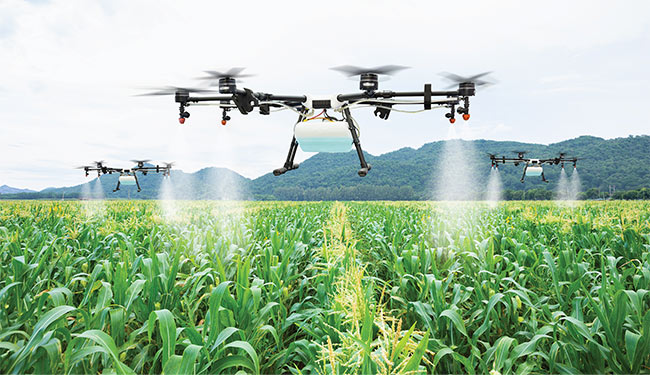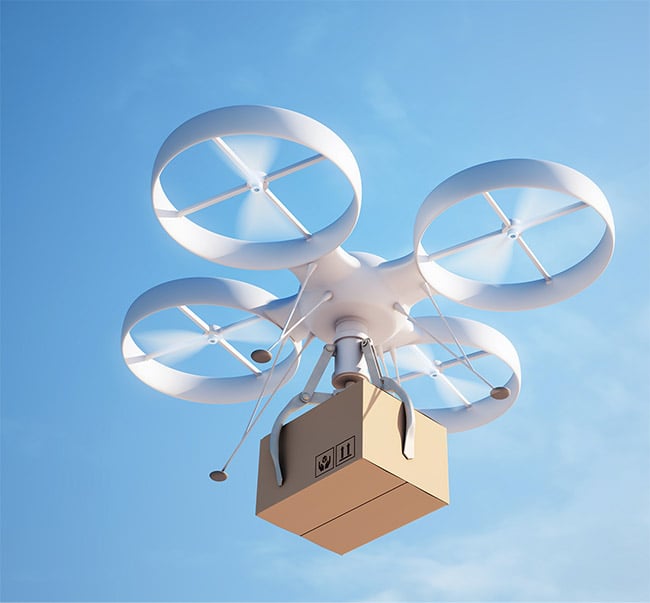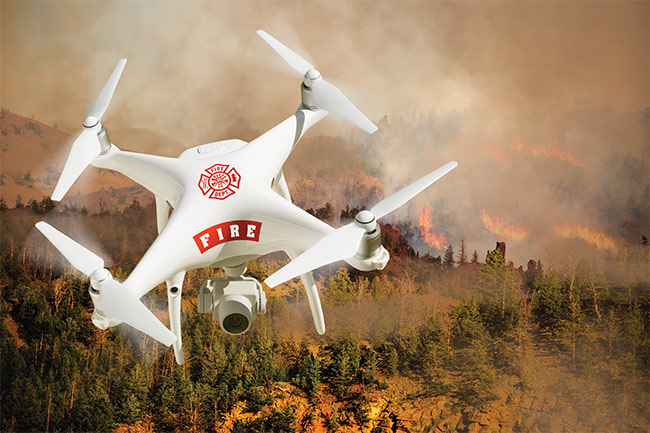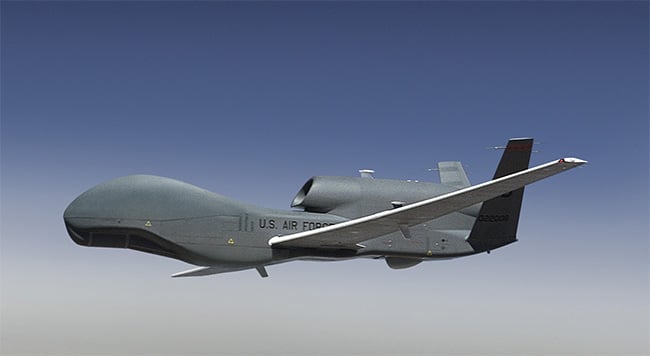As UAVs increasingly fly over remote, GPS-denied areas, they are utilizing a new generation of smaller, lighter, and less power-hungry optical gyroscopes.
JAMES SCHLETT, CONTRIBUTING EDITOR
The RQ-4 Global Hawk, Northrop Grumman’s high-altitude remotely piloted aircraft, has a maximum takeoff weight of 32,250 lb. The platform’s massive size affords it the ability to carry a Kearfortt airborne navigation system, which
includes, among its most important
sensors, a monolithic ring-laser gyroscope (RLG) that weighs 4.5 lb, measures just over 81 in., and uses 15 W of power.



Integrated photonics are shrinking optical microscopes and opening doors to the UAV middle market for smaller aerial platforms. Potential applications include agriculture (top), package delivery services (middle), and remote monitoring and inspection (bottom). Courtesy of Advanced Navigation.
However, the demands are growing for unmanned aerial vehicles (UAVs) that are smaller, able to operate in environments with limited or no GPS guidance, and capable of delivering enhanced pointing (roll/pitch/heading) accuracy for mapping applications. All of these trends are fueling the drive to reduce the dimensions of ring-laser and fiber optic gyroscopes to a fraction of those currently on board the Global Hawk. In some cases, this means fabricating smaller components for RLGs, or replacing parts of fiber optic gyroscopes (FOGs) with photonic chips or hollow-core fibers.
The Sagnac effect
Optical gyroscopes precisely measure the angular velocity and orientation of a UAV by employing an embedded Sagnac interferometer, which comprises two coils of optical fiber arranged so that the light from a single-source travels clockwise in one, and counterclockwise in the other. Rotation of the coils in space causes a phase shift in the combined outputs measured by a detector that reveals a corresponding change in a UAV’s angular velocity and orientation. RLGs similarly rely on the Sagnac effect to calculate rotation, but they use lasers that travel through a system of mirrors instead of fiber optic coils.
“One of the critical requirements of UAVs is operation in GPS-deprived
environments,” said Frank Weiss, the senior vice president of aerospace and defense at G&H Group. “This is most prevalent in military applications but can be useful in autonomous terrain mapping as well. In this application, it is critical to maximize the time of flight available under autonomous navigation. Working from a defined reference and high-
accuracy starting point and handing off these precision coordinates to an autonomously guided platform, a high-stability, low-drift gyro will perform better and for longer periods of time. RLG is well suited for this.”
Middle-market UAVs
The rollout of smaller, more lightweight optical navigation technologies would expand opportunities in the UAV market. The market is divided into five groups categorized by maximum gross takeoff weight, normal operating altitude, and airspeed.
Group 5, into which the Global Hawk falls, encompasses the largest and most capable platforms, while Group 1 UAVs represent the smallest models.
“Some of the new, smaller FOG and RLG sensors … could bring this technology from high-end UAVs down into more of the middle of the market — Group 3 or even Group 2,” said Matt Picchetti, vice president of navigation and sensors for Honeywell Aerospace.
In partnership with the U.S. Defense Advanced Research Projects Agency (DARPA), Honeywell is working on silicon photonics solutions, which Picchetti said will have wide-ranging applications, including next-generation optical gyroscopes. Photonic integrated circuits (PICs) are enabling FOGs to offer better reliability, a smaller footprint, and more scalable technology than previous versions.
In January, the Santa Clara-based ANELLO Photonics announced what it described as the world’s first optical gyroscope based on silicon photonics. The low-noise and low-drift optical gyroscope leverages PIC technology to replace the discrete coupler/circulator, detector, and modulator components of a conventional FOG with a compact system on a chip.
ANELLO’s silicon PIC replaces the conventional fiber spool with an embedded silicon nitride (SiN) waveguide, and directly couples in light from a single chip source. By leveraging SiN, the waveguide delivers less than 0.5 dB/m optical loss, a tiny bend radius, and tremendous polarization extinction. ANELLO worked with Tower Semiconductor to integrate the SiN waveguide onto a chip.
The gyroscope this produced weighs about 1 lb, measures 107 × 38 × 127 mm, and consumes less than 1.3 W of power.

The use of hollow-core fibers makes fiber optic gyroscopes less susceptible to external interference factors. Courtesy of Fraunhofer IZM.
ANELLO CTO Michael Horton described the device as the world’s smallest and lowest-power gyro and said any UAV fitting into Class 5 or below will benefit from the new silicon photonics optical gyro due to the component’s reduced size.
“ANELLO’s gyro measures 8 cubic inches as compared to the dimensions of a conventional optical gyroscopic inertial measurement unit, which typically occupies a minimum of about 30 cubic inches. Drones are extremely payload-size constrained,” Horton said.
Lithium niobate PICs
Other chip-based optical gyroscopes are utilizing the lithium niobate material platform. Last fall, Advanced Navigation, based in Sydney, Australia, unveiled what it described as the world’s first fully digital FOG.

Northrop Grumman’s RQ-4 Global Hawk is among today’s largest, heaviest, and longest-range unmanned aerial vehicles (UAVs), which allows it to carry a sizeable ring-laser gyro for navigation and control. Integrated photonics, however, are helping to miniaturize optical gyroscopes and are opening the use of these optical navigation systems to smaller UAV platforms.
Courtesy of Northrop Grumman.
“Previously, lithium niobate chips
were a crucial part of FOG systems, but they were discrete devices, basically a y-splitter and a phase modulator,” said Arnan Mitchell, the director of the Integrated Photonics and Applications Centre at the Royal Melbourne Institute of Technology and a key partner in developing Advanced Navigation’s digital FOG technology. “It is now possible to have very complex multiplexed systems all integrated onto one chip — this makes far more sophisticated systems possible both in the analog and digital domains.”
The chips for Advanced Navigation’s digital FOG build on a thin film of lithium niobate on a silicon wafer. “However, the performance of silicon itself, primarily in terms of loss, is not sufficient. The other alternative is [silicon] nitride, which can have very low loss, but does not offer modulators,” Mitchell said.
Unmanned Aerial Vehicle Categories

Courtesy of U.S. Army Unmanned Aircraft Systems Roadmap (2010-2035), U.S. Army UAS Center of Excellence.

Leveraging silicon photonics technology, new optical gyroscopes are able to integrate the discrete coupler/circulator, detector, and modulator in a smaller form factor. An embedded silicon nitride waveguide replaces the conventional fiber spool. Courtesy of ANELLO Photonics.
Advanced Navigation’s CEO and co-founder, Xavier Orr, said the digital FOG’s 5.5-lb, 160- × 140- × 115.5-mm footprint and 15 W of power consumption represent a 40% reduction compared to conventional systems. This comparison does not apply to ANELLO’s chip-based gyroscope. But Orr noted that subsequent generations of the company’s digital FOG, scheduled for releases in 2024 and 2025, will feature further reductions in size, weight, power, and cost (SWaP-C).
Displacing MEMS
As FOGs become smaller, lighter, and more cost-effective, the technology is better suited to compete for many applications that are currently using MEMS-based gyros, Orr said, adding that chip-based FOGs could become a disruptive technology in the UAV market.
Although both FOGs and RLGs are more accurate and reliable than MEMS by an order of magnitude, they are also more costly and averse to high temperatures.
Mitchell noted that high-performance MEMS sensors are available in the $100 range. Their performance can be further improved simply by hermetically packaging them in a helium environment, though that pushes their price up by several
thousand dollars. Even so, this is still cheaper than most FOGs. It is now
becoming more possible that integrated photonics could enable simpler compact FOG solutions that offer improved performance versus MEMS at a more competitive price point.
This integration could further enable a range of products that interface more easily with MEMS and other navigational technologies. “I think you will see the interface points between these offerings stabilize, and more emphasis will then be placed on fleshing out and commoditizing the solutions in each range,” Mitchell said.
Shock and vibration both pose more challenges to FOG technology than to MEMS-based gyros, though Orr said that the former “has come a long way with its shock and vibration tolerance,” thanks largely to the increased incorporation of once-fragile optical components onto integrated chip platforms.
Temperatures greater than 85 °C are
another threat to the performance of optical gyros, especially for silicon photonics-based devices. ANELLO’s Horton said reductions in source power as well as integration of sources on-chip will improve thermal tolerances.
Added fiber
Hollow-core fibers (HCFs) offer another alternative to improving the performance and reliability of FOGs, including their resistance to electromagnetic interference. Like normal fibers, HCFs are drawn from glass, but the core through which light is guided is hollow.
The advantage of HCFs is that their effective index of refraction is not dependent on electric and magnetic fields, and their birefringence is far less temperature-dependent than it would be in glass fiber, said Wojciech Lewoczko-Adamczyk, a researcher with the Fraunhofer Institute for Reliability and Microintegration IZM in Berlin.
In the absence of electromagnetic interference and high temperatures, HCFs should perform as well as traditional fibers, though the larger diameters of less mature HCF coils have disadvantages compared to interferometric FOGs that can make HCFs impractical for small UAVs.
HCFs, nevertheless, show promise aboard UAVs employing resonant FOG configurations. Such hollow-core resonant FOGs incorporate a fiber ring resonator and require much shorter fiber lengths than interferometric FOGs.
Although this new fiber gyroscope technology is still under development, it may overcome some obstacles of conventional interferometric FOGs, particularly through reduction of propagation losses and losses due to bending, according to Lewoczko-Adamczyk.
Miniaturization
Compared to FOG systems, RLG sensors are extremely rugged against shock, vibration, and temperature. However, Orr noted that RLG technology requires mechanical dithering to prevent lock-in
during stationary conditions. “This mechanical dithering generates noise and signatures that may be undesirable for some applications,” he said.
The ruggedness of the optics within RLG devices is further aided by coatings designed to survive extreme environmental conditions, as well as by substrate materials with high mechanical stability, according to Adam Morrow, who is precision optics product manager for G&H.
Miniaturization of RFG components is improving SWaP-C and making the technology more competitive with FOG devices, according to Morrow. To maintain the high performance of RFGs with a reduced form factor, ultraflat polishing and finishing of critical RLG mirrors and transducers have proved essential. But further reductions in size and power may hinge on advancements in the substrates used for RLG frames.
“Size limits are a function of the overall optical system design of the RLG, but weight reductions can be made in the frame,” Morrow said. “In doing so, care must be taken to not impair the mechanical stability of the RLG. Outside of the precision optical components, cost, and power consumption reductions can be looked at for the laser source as well.”